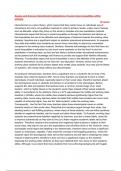Essay
Assess and discuss interactionist explanations of social class inequalities within schools.
- Vak
- Instelling
this is a 40 marks A* guaranteed essay example for the social inequalities topic for sociology. the question; Assess and discuss interactionist explanations of social class inequalities within schools is worth 40 marks and this achieved 40/40 marks.
[Meer zien]












